Operation Axis. How the Wehrmacht captured Northern and Central Italy
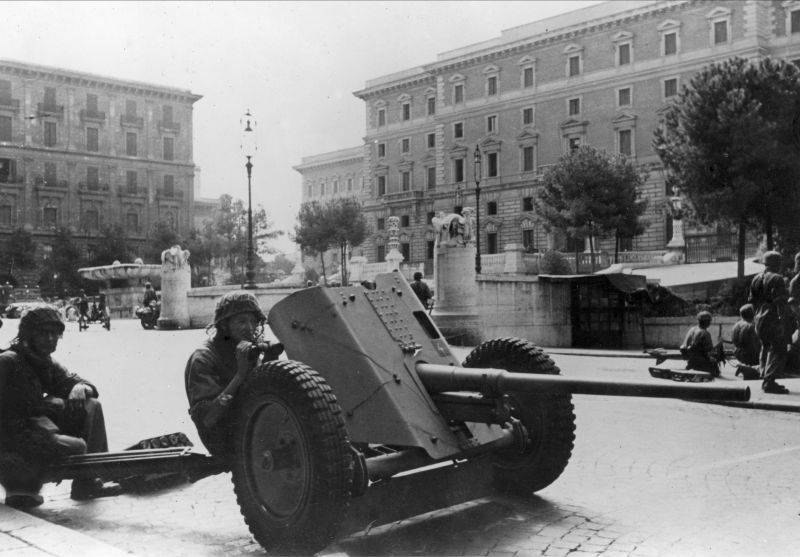
German paratroopers from a 42-mm PaK 41 anti-tank gun on the street of Rome. September 1943
"45 days"
The Italian elite and society, frightened by the prospect of complete defeat in the war, opposed Mussolini's fascist regime. On July 25, 1943, Mussolini was arrested (“How the fascist rule in Italy ended”). The fascist party was dissolved. The Nazis offered no resistance. Representatives of big capital, monarchists and the military were united in their desire to avoid capitulation and occupation of Italy and wanted to shift to the Duce all responsibility for the policy, which until that moment they had fully supported.
The new government was headed by Marshal Pietro Badoglio. Badoglio announced that the war continues, Italy remains faithful to its allied obligations. The period from July 25 to September 8, 1943 was included in history Italy as "45 days".
On the one hand, anti-fascist forces, democrats, socialists and communists became more active in the country. Crowded anti-fascist demonstrations swept across the country. Riots broke out in large industrial centers, led by communists. Progressive forces demanded Italy's withdrawal from the war and the restoration of democratic rights and freedoms.
On the other hand, the new Italian authorities led by Badoglio, who were backed by the interests of big capital, the bourgeoisie and monarchists, sought to avoid radical changes within the country, to take Italy out of the war, concluding a secret separate peace with the allies and avoiding occupation and turning the country into a battlefield . On July 26, a state of siege was introduced in the country, all meetings on the streets were prohibited, and troops were given the right to shoot at the crowd. At the same time, in order to reassure the public, the government dissolved the fascist party, declared a political amnesty and agreed to the restoration of trade unions.
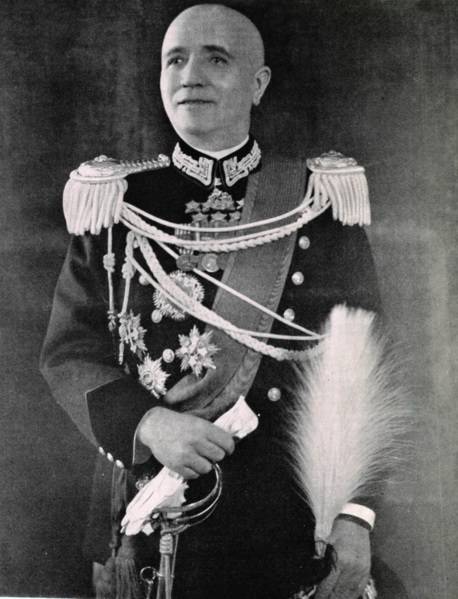
Portrait of Marshal Pietro Badoglio, leader of Italy after the fall of Benito Mussolini
Italian armed forces
Italian troops were demoralized by defeats in Russia and Africa. Their morale, which was already low, dropped to zero. The ground forces consisted of more than 80 divisions (of which more than 45 formations were located in continental Italy), but their weapons were weak, and their manpower and equipment levels were low. Only a few formations had up to 70% of soldiers and officers. For the only one tank the division lacked tanks.
The stationary coastal defense divisions (almost a quarter of the army) were especially weak in combat training, motivation, weapons and equipment, as the battles in Sicily showed (“How the German 14th Panzer Corps held back the advance of two allied armies for 38 days”).
Italian troops were scattered throughout southern Europe. The Italian 4th Army (12 divisions) was stationed in southeastern France and northwestern Italy. In Northern Italy, the 8th Army (13 divisions) was restored - the remnants of its divisions returned from Russia, it was never able to restore even minimal combat effectiveness. The 5th and 7th armies took up defensive positions on the Apennine Peninsula, Corsica and Sardinia. The 6th Army (10 divisions) was defeated in Sicily. The 2nd, 9th and 11th armies (31 divisions) served in Greece, Albania and Yugoslavia. The best Italian divisions were located outside the country - in southern France, Corsica, the Balkans and islands in the Aegean Sea.
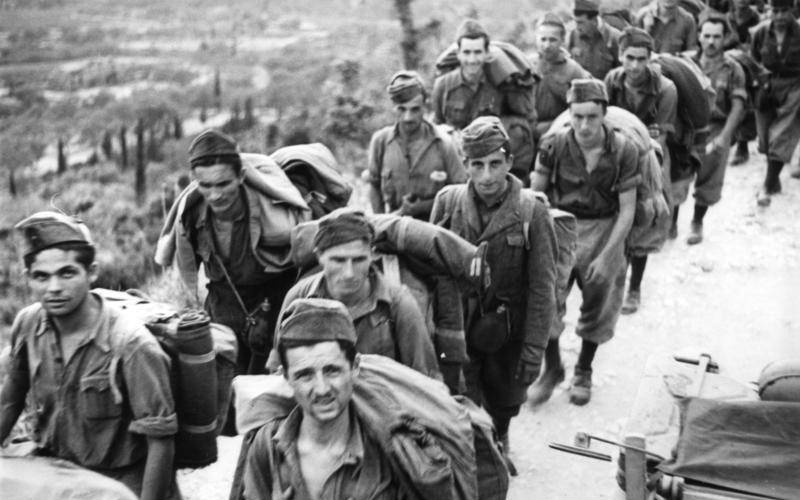
Italian soldiers in Corfu. 1943
The concentration of available troops for the defense of Northern Italy and Rome was difficult due to the destruction of the railway network, which was only growing, and the loss of almost the entire fleet of vehicles in North Africa.
Aviation consisted of over 1 vehicles, but more than half lost their combat effectiveness. In service fleet there were 6 battleships, 2 heavy and 6 light cruisers, 28 destroyers, 27 destroyers, 56 submarines. The ships were practically unable to conduct combat operations at night, had little fuel, and the personnel did not want to fight. Therefore, the military representative of the Third Reich at the Italian General Staff, Admiral Ruge, made the corresponding conclusion: “The Italian Navy means practically nothing to repel a possible enemy landing.”

Capitulation of Italy
England and the USA reacted favorably to the change of power in Italy. On July 30, Roosevelt wrote to Churchill that they should enter into negotiations with any person or persons in Italy who would secure disarmament and prevent chaos. Churchill hoped that the capitulation of the Italian armed forces in Southern France, Italy, and the Balkan Peninsula would lead to Anglo-American forces controlling the Apennine Peninsula and the Adriatic Sea, and the Germans would be forced to retreat north to the Sava-Danube line. The Allies will occupy Greece without any problems.
To force the Italians to surrender as soon as possible, the Allies intensified the bombing of Italian cities. On August 13, 1943, 400 bombers attacked Rome. At the same time, Anglo-American aircraft bombed Milan, Turin, Genoa and other cities. The priority targets were railways, airfields and other transport infrastructure. However, bombs also fell on residential areas. Hundreds of civilians died.
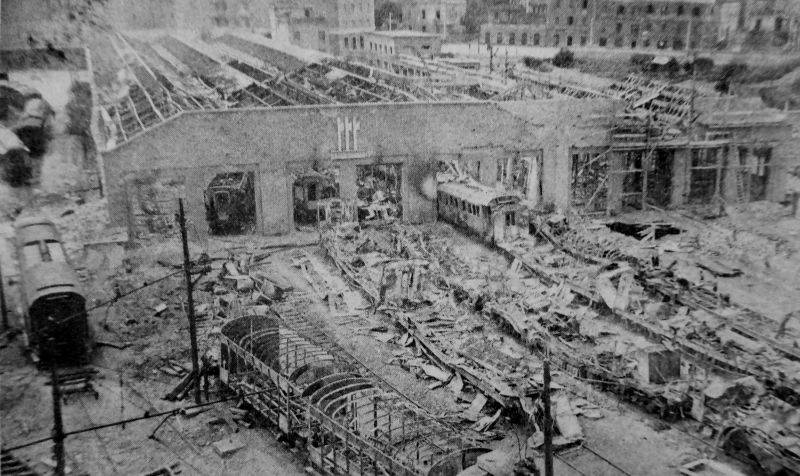
A railway marshalling yard in Rome, destroyed by Allied bombing. July 1943
The Badoglio government, continuing to assure Berlin of its loyalty, set a course for exiting the war. Rome was afraid to openly oppose the Germans. The Italians sought to ensure that a truce was concluded only after Anglo-American troops landed in large forces in Italy. The Allies spoke vaguely of landing 6 divisions in the Rome area, one airborne division on airfields near Rome, and 9 divisions on the west coast. The Italians sought specific information about the landing of troops to cover the Allies. The Allies believed that the Italians were playing for time.
On August 15, General Castellano arrived in Madrid, met with the British ambassador S. Hoare and announced Rome's readiness to join the United States and England as soon as their troops landed in continental Italy. On August 19, Castellano held negotiations in Lisbon with American General B. Smith. Ten days later, the Italian general returned to Italy with the text of the terms of the truce. The conditions were difficult for Rome and dashed the hopes of the Italian elite to avoid turning their country into a battlefield.
Rome had to surrender Corsica, Sardinia and the entire continental part of the country to the allies to create Anglo-American bases. Italy also surrendered its fleet and aviation, and provided full access to its ports and airfields. Moreover, this did not depend on the presence of Germans on them. That is, the Italians had to engage in battle with the Germans before the Allies arrived, which the Italian authorities wanted to avoid.
On the night of September 1, Rome agreed to surrender on the terms of the Allies. Churchill and Roosevelt informed Stalin of the results of the negotiations. Moscow approved of the Allies' actions.
On September 3, 1943, the Italian representative Castellano and the chief of staff of the Allied forces in the Mediterranean theater B. Smith signed an armistice agreement, which provided for the unconditional surrender of the Italian armed forces. The promulgation of the act of surrender was postponed until the landing of allied troops in mainland Italy. On September 3, with air and naval support, British troops crossed the Strait of Messina and landed in southwestern Calabria.
On September 9, 1943, Allied forces landed in the Bay of Salerno in southwestern Italy. The day before, the Allies announced on the radio that Italy was asking for an armistice, and it had been signed. The Italian government had to announce the beginning of the truce. The Italian armed forces were ordered to cease hostilities against the Allies but to repel any attack. That is, the Italian troops had to resist the Germans.
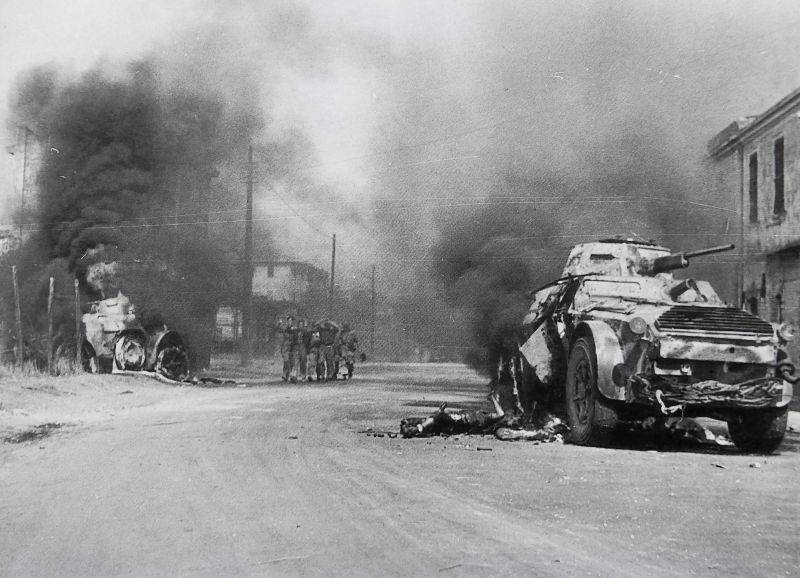
Italian armored cars AB 41 (Autoblinda AB 41) destroyed by German soldiers in the suburbs of Rome. Italian soldiers who have surrendered are walking down the street. September 1943
Operation Axis
Back on May 21, 1943, the head of the Wehrmacht High Command (OKW), Field Marshal Keitel, prepared a rough plan for possible actions in Italy. This plan included several military operations at once: Operation Alaric to invade mainland Italy and capture local key installations; Operation Student to capture Rome. The Germans also planned to neutralize Italian troops on the Balkan Peninsula and in France.
The Germans, under the pretext of preventing enemy landings in Northern Italy and the landing of paratroopers in the Alps, transferred several divisions to northern Italy from Southern Germany and France. The Germans did not even coordinate this with the Italian authorities, as they had done before.
Hitler at the end of July 1943 wanted to send troops to Rome, arrest the king and Badoglio, free Mussolini and restore the fascist regime. However, he temporarily abandoned these plans due to caution, ignorance of where Mussolini was being held, and Rome's official willingness to maintain the alliance.
On August 6, a German-Italian conference was held in Treviso near Venice. On the German side, Ribbentrop and Keitel took part in it, and on the Italian side, the new Foreign Minister Guariglia and Chief of the General Staff Ambrosio. The conference took place in an atmosphere of general mistrust. The Italians formally maintained an alliance with Germany and asked for a large number weapons and military materials for the defense of the peninsula. The Germans did not want to provide weapons to unreliable allies. Ambrosio also asked for the transfer of as many Italian divisions as possible from the occupied territories for the defense of Italy. The Germans also ignored this request.
On August 15, the second German-Italian meeting took place. It was devoted to the defense of Southern Italy. It was about the German Army Group B, led by Rommel. On August 19, she was redeployed to Northern Italy. The question of the withdrawal of Italian troops from France and the Balkans was also raised again. The Germans firmly planned to defend Northern Italy. The Italians tried to return their troops to their homeland.
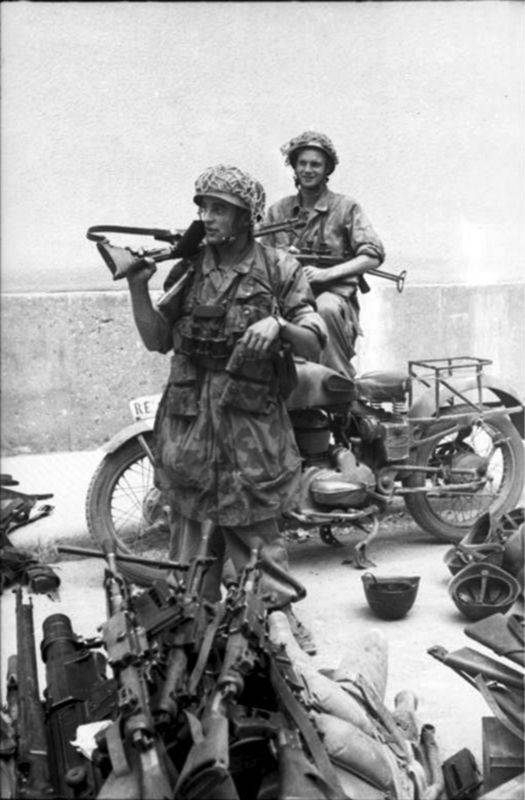
German paratrooper with an FG-42 automatic rifle. In the foreground are weapons confiscated from Italian soldiers. The photo was probably taken after September 8, 1943, when the Germans began disarmament of the former allies
Preparing for an operation
In Berlin they understood that after Mussolini's arrest, a break with Italy was inevitable. The question was when and in what form this break would occur. Therefore, the German leadership rejected all Italian proposals to transfer large German forces to Southern Italy to repel a possible enemy landing. The Germans understood that in the event of a break with the Italians, these divisions in the south of the peninsula would be trapped. The small German units in Southern Italy remained without support.
Rommel's group remained in Northern Italy and partially advanced to the Apennine Mountains. The Germans were going to hold these territories in any case. German troops also occupied passes in the Alps that led to France, Germany and Yugoslavia. The Germans wanted to occupy the main naval base of La Spezia under the pretext of defense against enemy landings, but in reality to capture the Italian Navy. But the Italians themselves occupied La Spezia with large forces and declared that for them the defense of an important port was a matter of prestige.
By the beginning of September 1943, the German command had 17 divisions and 1 brigade in Italy. They united into army groups "South" and "B" under the command of Field Marshals Kesselring and Rommel. In Southern Italy - in Calabria and Puglia, the 76th Tank Corps (29th Motorized, 1st Parachute and part of the 26th Tank Divisions) was based. In the southwest of the Apennine Peninsula in the area of Salerno, Naples, and Gaeta, the defense was held by two tank divisions (16th and Hermann Goering) and 15th motorized divisions, which were part of the 14th Corps of the 10th Army. The 90th Motorized Division remained in Sardinia. The 3rd Motorized, 2nd Parachute and part of the forces of the 26th Panzer Division, which reported directly to Kesselring, were based in the Rome area.
Army Group B in Northern Italy had 6 infantry, 2 tank divisions and a motorized brigade. The Western and Central Mediterranean, including the south of France, Sardinia, Corsica and the northern part of Italy, were covered by 625 German aircraft, Central and Southern Italy - only 170 aircraft.
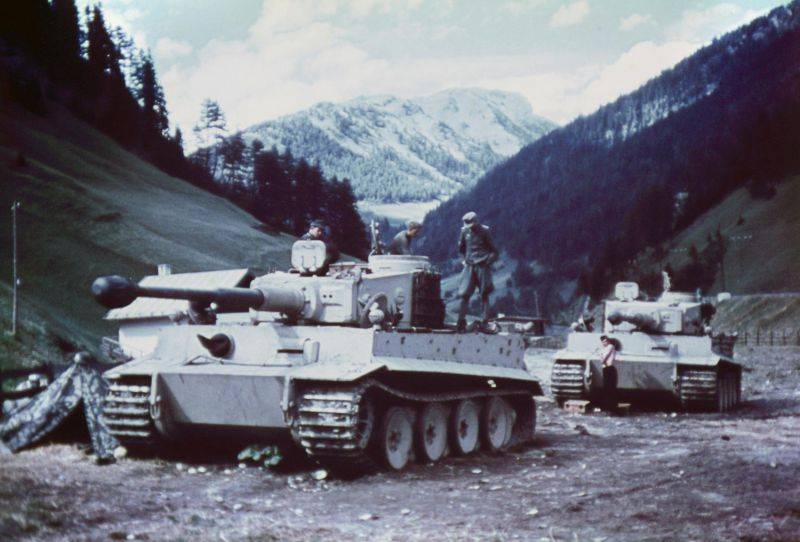
German tanks Pz. Kpfw. VI "Tiger" from the 508th Heavy Tank Battalion at the Brenner Pass near the Austro-Italian border during transfer to Italy. August 1943
The Germans flooded Italian transport and communications with their people, and at the same time created their own communications network. All German troops stationed in France, Italy and the Balkans received precise instructions: as soon as Italy leaves the war, upon a conditional signal, disarm and intern the Italian troops located in the area of their deployment.
The Italian military-political leadership understood everything. But he could not provoke the Germans with sharp decisions. Also, the Italian armed forces were too weak and lacked the motivation to fight their former allies. The Berlin-approved withdrawal of Italian troops from France and Yugoslavia, already dependent on a weak railway network, was delayed by the Germans, who were holding back wagons and coal for the locomotives. Italian protests were ignored, or the Germans were dissuaded by the need for urgent measures against the impending enemy attack.
The Italians warned their troops in August of a possible confrontation with the Germans with two secret orders. All headquarters and troop locations had to be carefully guarded; in the event of a conflict, Italian forces could launch counterattacks at important points against the Germans. However, in general, the Italian armed forces were not ready to confront the Germans; the announcement of the armistice came as a surprise to them. The troops did not receive precise instructions and were demoralized; on the contrary, the Germans acted quickly and decisively.
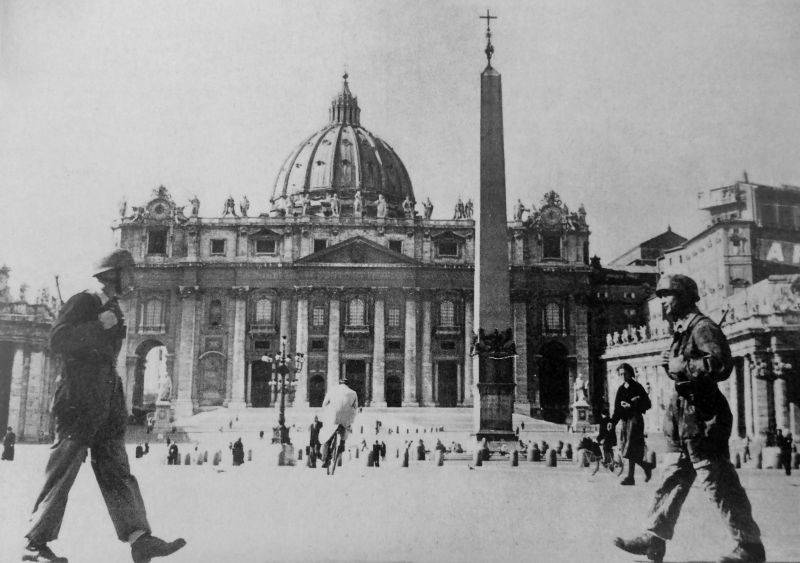
Sentinels of the German 2nd Parachute Division, cyclists and passers-by in the square in front of St. Peter's Basilica in the Vatican. After fighting in Rome on September 8–9, 1943, German troops established control over the capital of Italy and the Vatican
To be continued ...
Information